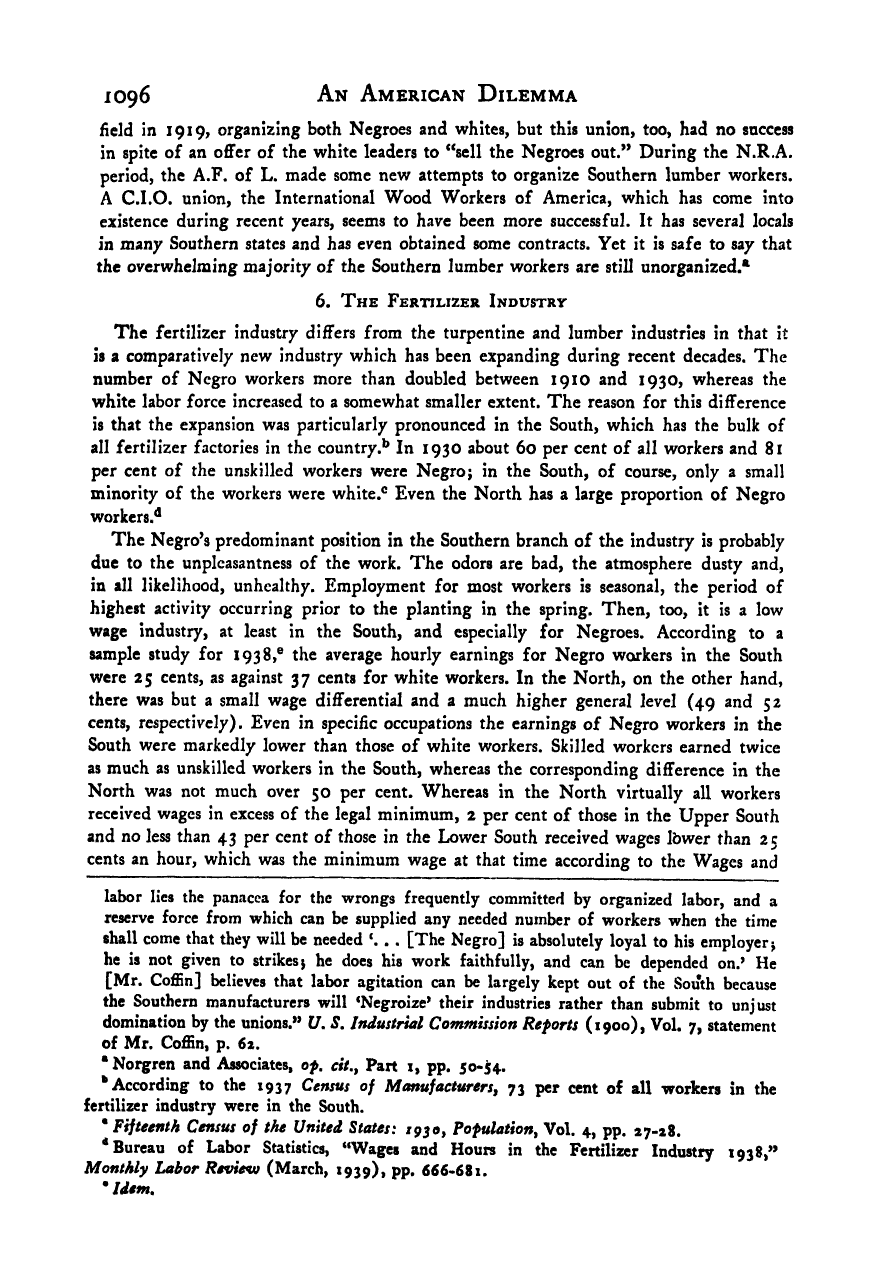Note: Gunnar Myrdal died in 1987, less than 70 years ago. Therefore, this work is protected by copyright, restricting your legal rights to reproduce it. However, you are welcome to view it on screen, as you do now. Read more about copyright.
Full resolution (TIFF) - On this page / på denna sida - Appendices - 6. Pre-War Conditions of the Negro Wage Earner in Selected Industries and Occupations - 5. Lumber - 6. The Fertilizer Industry

<< prev. page << föreg. sida << >> nästa sida >> next page >>
Below is the raw OCR text
from the above scanned image.
Do you see an error? Proofread the page now!
Här nedan syns maskintolkade texten från faksimilbilden ovan.
Ser du något fel? Korrekturläs sidan nu!
This page has never been proofread. / Denna sida har aldrig korrekturlästs.
1096 An American Dilemma
field in 1919, organizing both Negroes and whites, but this union, too, had no success
in spite of an oflfer of the white leaders to “sell the Negroes out.” During the N.R.A.
period, the A.F. of L. made some new attempts to organize Southern lumber workers.
A C.I.O. union, the International Wood Workers of America, which has come into
existence during recent years, seems to have been more successful. It has several locals
in many Southern states and has even obtained some contracts. Yet it is safe to say that
the overwhelming majority of the Southern lumber workers are still unorganized/
6. The Fertilizer Industry
The fertilizer industry differs from the turpentine and lumber industries in that it
is a comparatively new industry which has been expanding during recent decades. The
number of Negro workers more than doubled between 1910 and 1930, whereas the
white labor force increased to a somewhat smaller extent. The reason for this difference
is that the expansion was particularly pronounced in the South, which has the bulk of
all fertilizer factories in the country.** In 1930 about 60 per cent of all workers and 8
1
per cent of the unskilled workers were Negro; in the South, of course, only a small
minority of the workers were white.® Even the North has a large proportion of Negro
workers.^
The Negro’s predominant position in the Southern branch of the industry is probably
due to the unpleasantness of the work. The odors are bad, the atmosphere dusty and,
in all likelihood, unhealthy. Employment for most workers is seasonal, the period of
highest activity occurring prior to the planting in the spring. Then, too, it is a low
wage industry, at least in the South, and especially for Negroes. According to a
sample study for 1938,® the average hourly earnings for Negro workers in the South
were 25 cents, as against 37 cents for white workers. In the North, on the other hand,
there was but a small wage differential and a much higher general level (49 and 52
cents, respectively). Even in specific occupations the earnings of Negro workers in the
South were markedly lower than those of white workers. Skilled workers earned twice
as much as unskilled workers in the South, whereas the corresponding difference in the
North was not much over 50 per cent. Whereas in the North virtually all workers
received wages in excess of the legal minimum, 2 per cent of those in the Upper South
and no less than 43 per cent of those in the Lower South received wages Ibwer than 25
cents an hour, which was the minimum wage at that time according to the Wages and
labor lies the panacea for the wrongs frequently committed by organized labor, and a
reserve force from which can be supplied any needed number of workers when the time
shall come that they will be needed ‘. . . [The Negro] is absolutely loyal to his employer;
he is not given to strikes; he does his work faithfully, and can be depended on.’ He
[Mr. Coffin] believes that labor agitation can be largely kept out of the South because
the Southern manufacturers will ‘Negroize’ their industries rather than submit to unjust
domination by the unions.” U. S, Industrial Commission Reforts ( 1 900) , Vol. 7, statement
of Mr. Coffin, p. 62.
• Norgren and Associates, of, cit., Part i, pp. 50-54.
^According to the 1937 Census of Manufacturers^ 73 per cent of all workers in the
fertilizer industry were in the South.
• Fifteenth Census of the United States: 1950, Pofulation, Vol. 4, pp. 27-28.
• Bureau of Labor Statistics, “Wages and Hours in the Fertilizer Industry 1938,”
Monthly Labor Review (March, 1939), pp. 666-681.
*Jdem.
<< prev. page << föreg. sida << >> nästa sida >> next page >>